Webbramverk, 1DV450
Vad är ett (webb-)API?
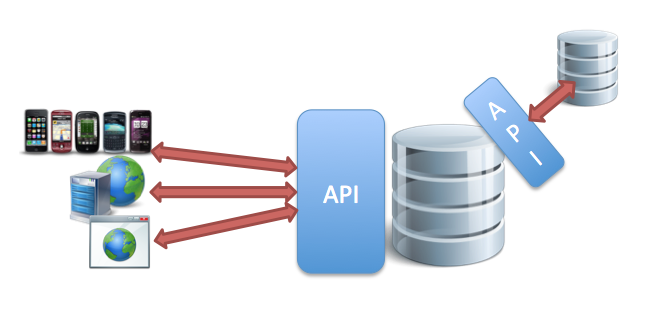
"API is UI to Data"
Synliggöra data Application programming interface Skillnaden från en webbapplikation Maskin till maskin Distribuerade system
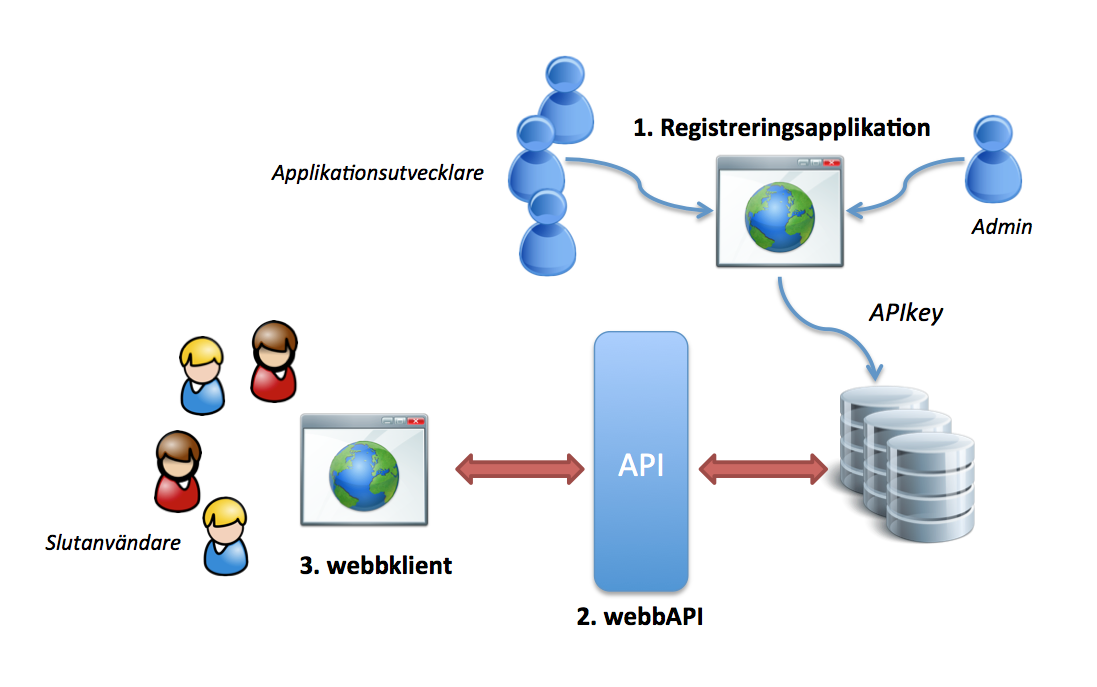

API Driven development
- Stöd för olika typer av klienter/plattformer
- Utbyta data mellan system/applikationer
- Modulärt, "separation of concerns"
- Lös koppling mellan klient och server (stateless) - Cache-barhet, Skalbarhet
- Microservices - Software architecture style
- APIer som produkt
Foto cc by: http://www.flickr.com/photos/teegardin/
Vi har data, utveckla ni (twitter) Plattformsoberoende, flera enheter och miljöer Skalbarhet, utbyggningsbart Mashups, en backend olika frontends
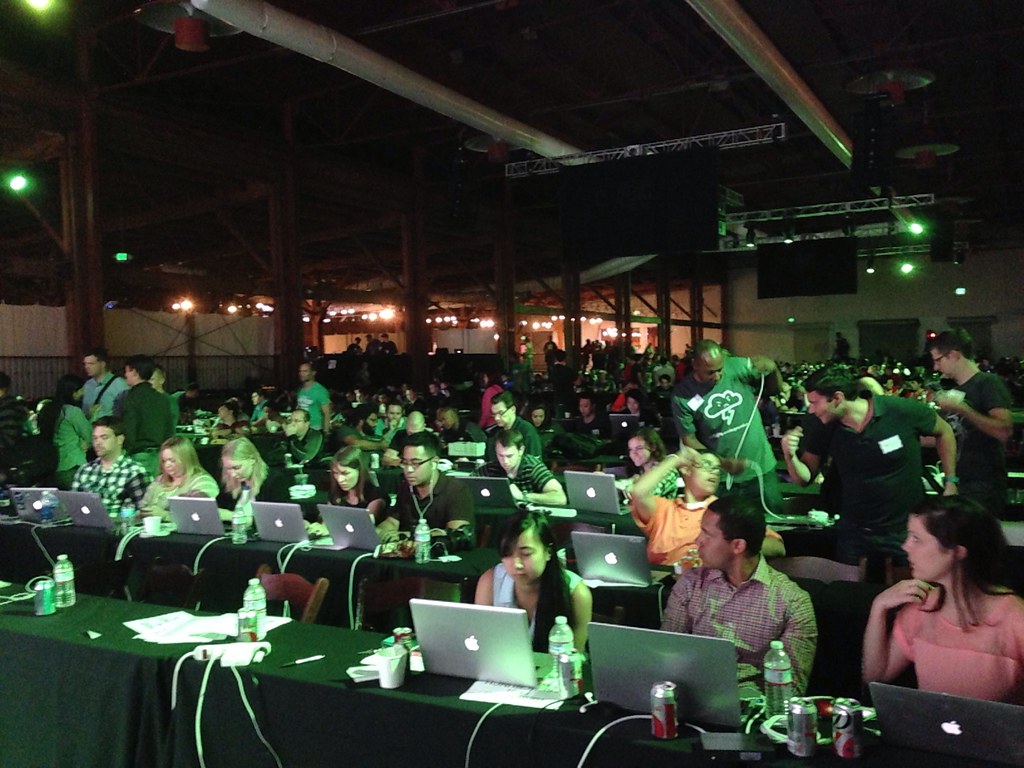
För vem skriver man ett API?
Andra utvecklare...
Du vet inte dina API-användares användningsfall
Foto cc by: http://www.flickr.com/photos/sylvainkalache/
Inga user cases. Vi vet inte hur vårt API kommer att användas.

Historik
Behov av att kunna utbyta information mellan applikationer,
tjänsteorienterad arkitektur, SOA
Web Services...
- CORBA / DCOM
- RPC (Remote procedure call)
- XML
- Web Service (WS-*)
- RESTful Web API
- MicroServices
Foto cc by Wilgengebroed on Flickr: https://www.flickr.com/photos/wilgengebroed/5514783718/
Web Service
Standardisering av W3C
XML, XML, XML
Möjlighet till automatgenererad kod
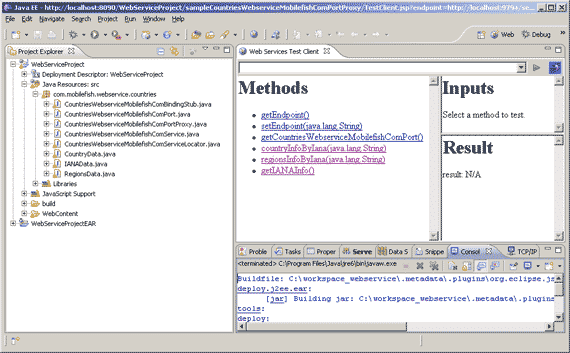
Enterprise, "Big Web services"
Transaction, Security, Hantering av state....osv
Web Service dumt namn mycket automatiskt, mycket overhead
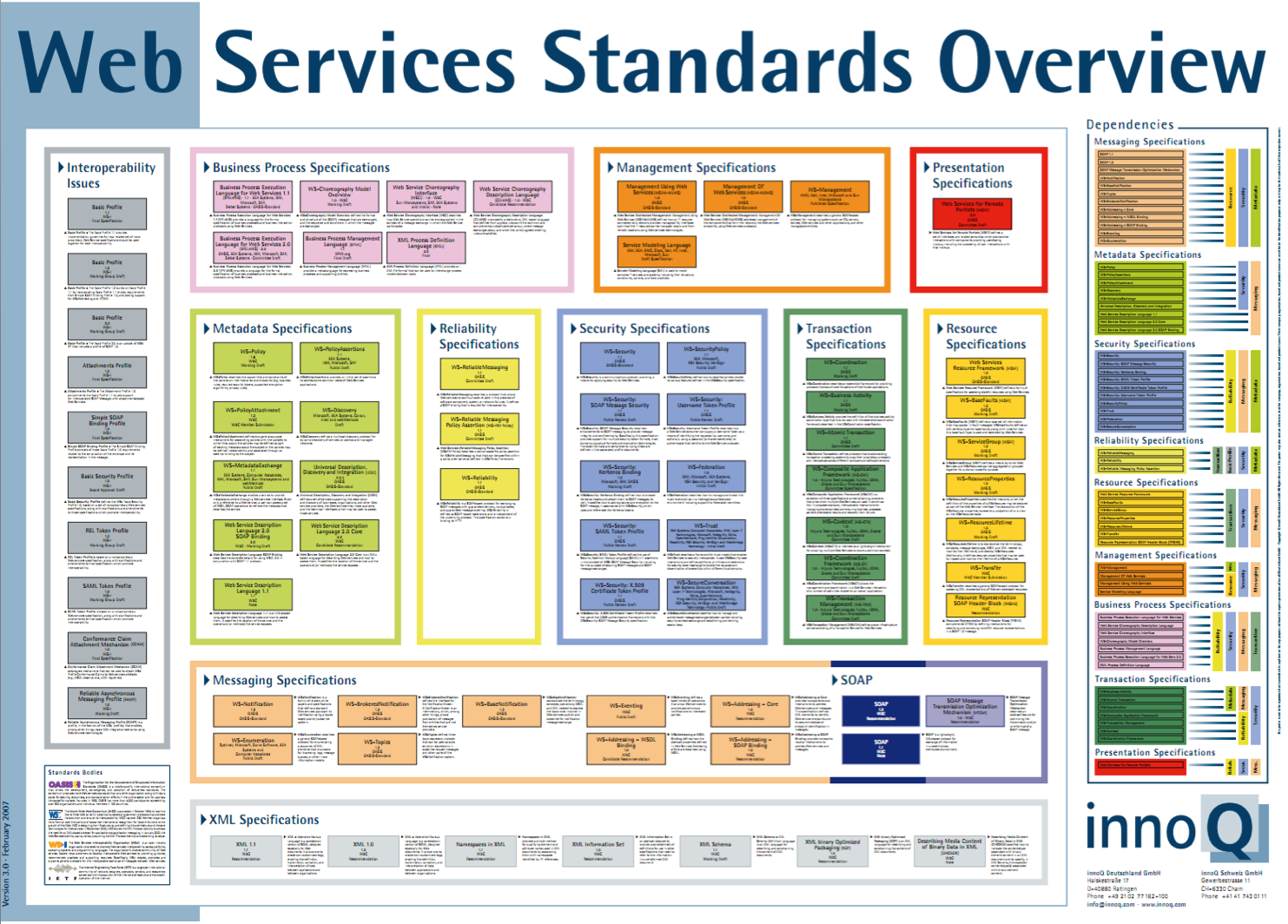
WSDL

SOAP
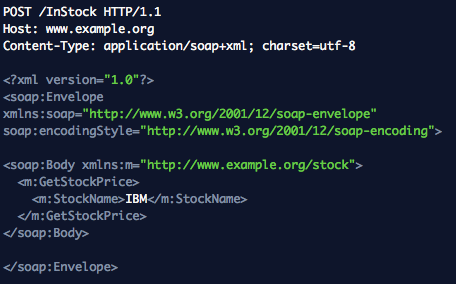
VS.
GET http://www.example.org/stockprice/IBM.xml

REST
Foto cc by: http://www.flickr.com/photos/joeshlabotnik/
REST
Representational State Transfer
Roy Fielding, 2000
”Architectural styles and the design of networked-based architecture”
http://www.ics.uci.edu/~fielding/pubs/dissertation/rest_arch_style.htm

REST användes egentligen som ett exempel på att visa hur webben fungerar
Roy författare till HTTP specifikationen, Apache HTTP server project

Vad REST inte är!
- Ingen standard, ingen RFC
- Inget protokoll
- Inget filformat
- Inget utvecklingsramverk
RESTful är en arkitektonisk stil
Foto cc by: http://www.flickr.com/photos/rhymereverie/
RESTafarian
eller pragmatiker?
"But it is not restful if you...."

Begrepp när man pratar REST
- Varje "sak" i vår tjänst/applikation är en resurs (resource)
- Varje resurs måste kunna adresseras (URL/addressability)
- En representation beskriver en resurs tillstånd (state)
- En resurs kan ha flera representationer (mutiple representations)
- REST är tillståndslöst på servern (stateless)
- Hypermedia as the engine of application state (HATEOAS)
- Bygger på de arkitektoniska principerna för webben
Foto cc by: http://www.flickr.com/photos/remek/

Varje "sak" är en resurs (resource)
- En resurs kan vara ett meningsfullt koncept
- Något man sparar i den databas
- Något du vill kunna länka till/användaren skulle vilja kunna få ut
- En produkt, en användare, en lista med filmer, alla kursen en student går, Användaren en annan användare följer...
- Resource instance, Resource collection
- Håll det enkelt och förutsägbart. Du vet inte dina användares användarfall
Foto cc by: http://www.flickr.com/photos/ginnerobot/
Varje resurs måste kunna adresseras via en URI
- http://www.api.example.com/users
- http://www.api.example.com/users/thajo
- http://www.api.example.com/users/234617
- http://www.api.example.com/users/thajo/projects
- http://www.api.example.com/projects/132654
Singular vs. plural?
id vs. name?
Hur djupt ska man nästla?
Studera andras APIer...
URLer - Anti-pattern
- http://www.api.example.com/?method=getUsersByUsername
- http://www.api.example.com/getUser
- http://www.api.example.com/createUser
- http://www.api.example.com/editUserByID
- http://www.api.example.com/users/GetProjectsByUserIDOrderByCity
- ...
Svårt att veta olika urler, stökigt
Använd HTTP-verbs för att beskriva "actions"
Ditt api behandlar resursen beroende på vilken HTTP-metod som klienten anropar din URL med
http://www.api.example.com/v1/users http://www.api.example.com/v1/users/129387
- GET - Hämta en resurs
- POST - Skapa en ny resurs (bl. a.)
- PUT - Uppdatera en (hel) resurs
- DELETE - Ta bort en resurs
- PATCH - Partiell uppdatering, Tillägg till HTTP
- HEAD - Endast headers
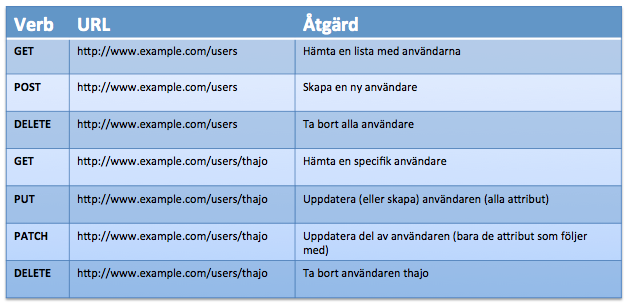

POST vs. PUT
- POST är vagt definierad i HTTP-specifikationen, "Data-handling process"
- POST-to-Append - POST används för att skapa nya resurser
- Overloaded POST - POST används till allt utom get (HTML-formulär)
- PUT - Modifiera en resurs tillstånd. Kan skapa om man skickar med nytt id. Vill man det?
Foto cc by: http://www.flickr.com/photos/dm-set/
Multipla representationer
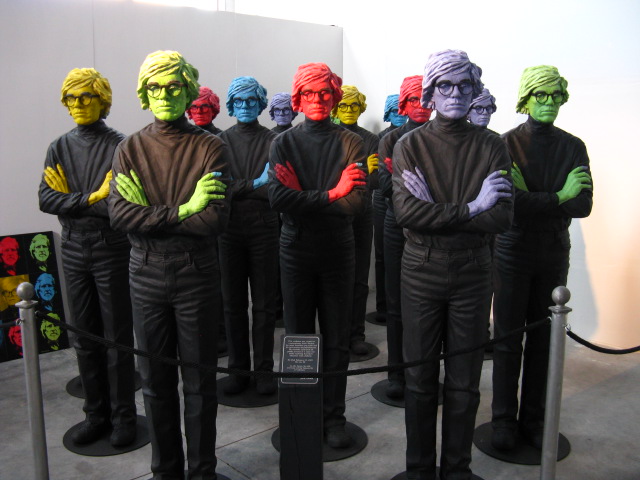
- En representation av en resurs kan ges i flera dataformat
- Klienten ska kunna efterfråga det dataformat man önskar via sin HTTP förfrågan
- Anges inte detta av klienten bör resursen returneras i ett "default" dataformat
- I sitt svar talar servern om i vilket dataformat svaret är (Content-Type)
Foto cc by: http://www.flickr.com/photos/crobj/
Accept-header
// I header från klienten Accept: application/xml, text/csv, text/plain Accept: application/json Accept: application/thajo+json Accept: application/vnd.github.v3+json
http://www.api.example.com/users/thajo.json
http://www.api.example.com/users/thajo.xml
// I header från server - berättar om dataformatet Content-Type: application/thajo+json
HTTP Status Code
Ditt API meddelar klienten genom fördefinierade statuskoder i HTTP
- 1xx - Informational
- 2xx - Successful
- 3xx - Redirection
- 4xx - Client Error
- 5xx - Server Error
- 200 OK
- 201 Created
- 204 No Content
- 400 Bad Request
- 401 Unauthorized
- 403 Forbidden

Exempel - Skapa en resurs
POST http://example.com/products
Accept: application/json
Content-Type: application/json
...
{
"product_name" : "Bultbräda 2000",
"price" : 324.50,
"category" : 3
}
Exempel - Skapa en resurs
201 Created
Content-Type: application/json
...
{
"id" : 123
"message": "A new product was created",
"link": "http://example.com/products/123",
"created_at": "2015-01-14T16:00:49Z",
"updated_at": "2015-01-14T16:00:49Z",
"category" {
"id": 3,
"category_name": "Toys",
"url": "http://example.com/categories/3"
"category_url" : "http://example.com/categories"
}
}
Exempel - Skapa en resurs (postman)
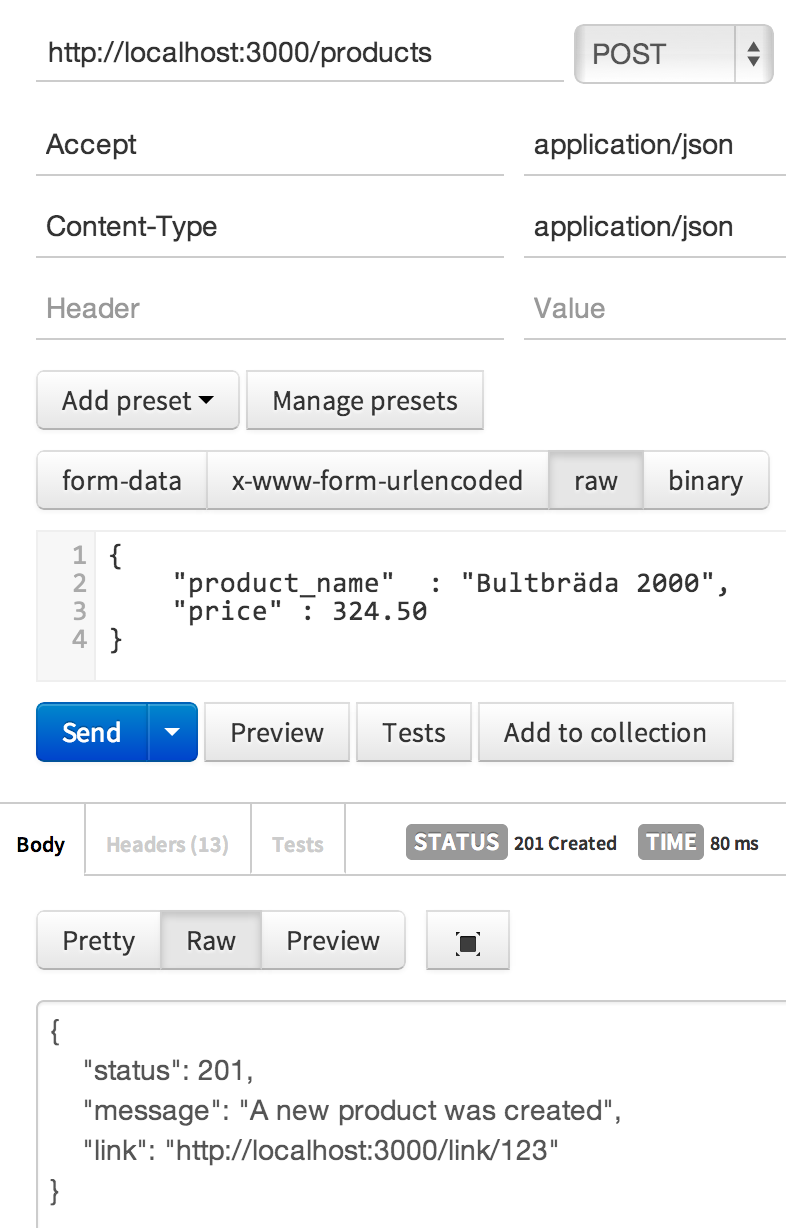
Exempel - Felmeddelande
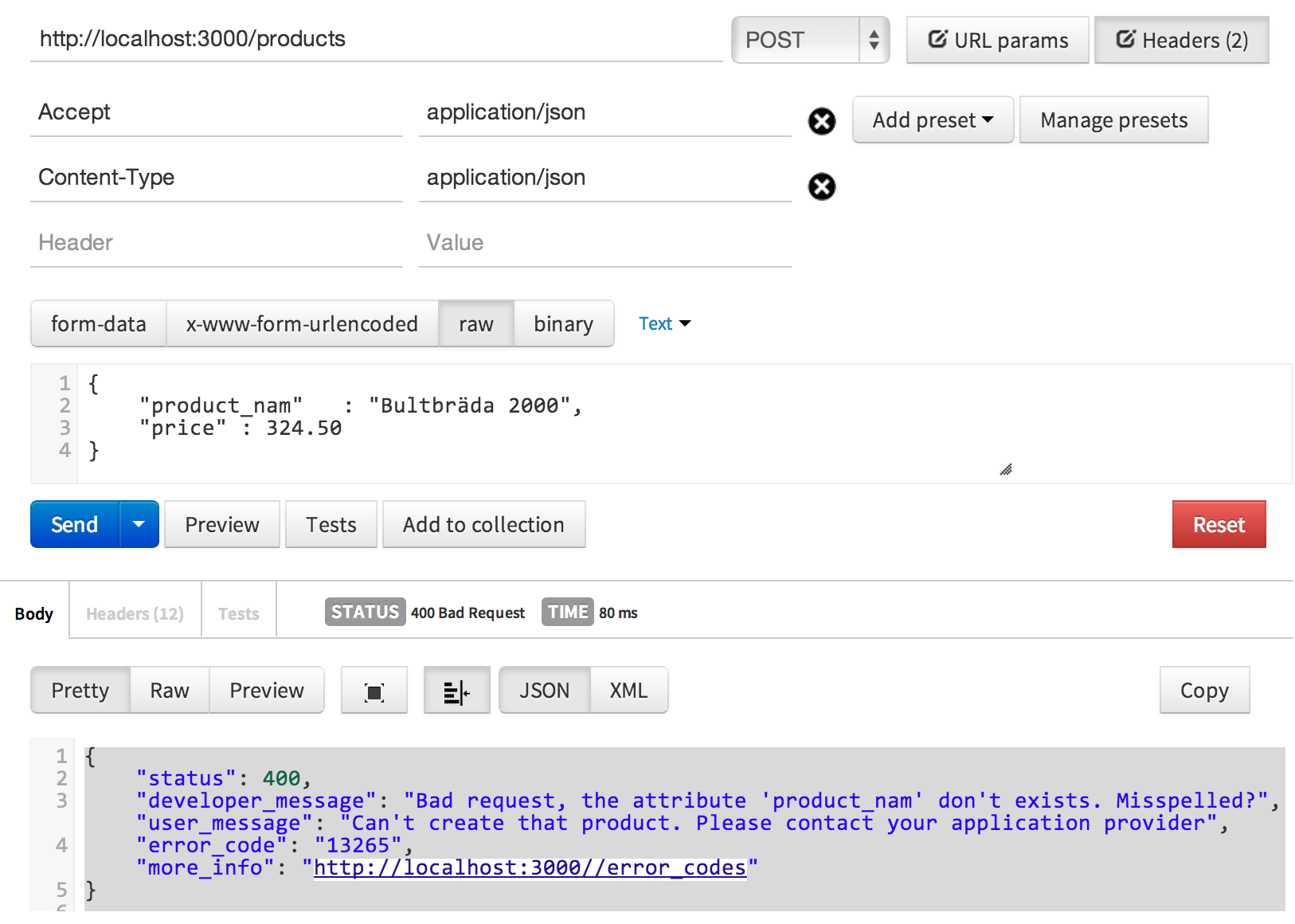
HATEOAS
Hypermedia As The Engine Of Application State
The model of application is an engine that moves from one state to another by picking alternative state transitions in current set of representations
- Current state - Beskrivs av representationen och dess dataformat
- Länkar/URL:er - Beskriver "the transition" till nästa "state"
- Inkludera länkar/URL:er i ditt APIs response
- Klienter bör kunna navigera sig i ditt API precis som man surfar
- En klient ska inte behöva bygga ihop en URL
- "Hypertext should be used to find your way through the API."
